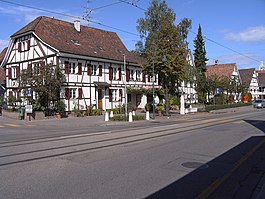Allschwil: Difference between revisions
Signalhead (talk | contribs) →Public Transport: "eventhough" ==> "even though": Two words, not one. |
|||
| Line 57: | Line 57: | ||
Tram 6: Allschwil-Basel-Riehen |
Tram 6: Allschwil-Basel-Riehen |
||
Tram 8: Kleinhüningen - Neuweilerstrasse (Although the Number 8 Tram terminates at Neuweilerstrasse in Basel, the border with Allschwil is less than 50 metres from this stop.) |
|||
Bus 31: Allschwil-Schifflände-Habermatten |
Bus 31: Allschwil-Schifflände-Habermatten |
||
Revision as of 13:13, 2 September 2009
Allschwil | |
|---|---|
 | |
| Country | Switzerland |
| Canton | Basel-Country |
| District | Arlesheim |
| Government | |
| • Mayor | Anton Lauber |
| Area | |
| • Total | 8.92 km2 (3.44 sq mi) |
| Elevation | 287 m (942 ft) |
| Population (31 December 2018)[2] | |
| • Total | 21,150 |
| • Density | 2,400/km2 (6,100/sq mi) |
| Time zone | UTC+01:00 (Central European Time) |
| • Summer (DST) | UTC+02:00 (Central European Summer Time) |
| Postal code(s) | 4123 |
| SFOS number | 2762 |
| ISO 3166 code | CH-BL |
| Surrounded by | Basel (BS), Binningen, Buschwiller (FR-68), Hégenheim (FR-68), Neuwiller (FR-68), Oberwil, Saint-Louis (FR-68), Schönenbuch |
| Twin towns | Pfullendorf (Germany), Blaj (Romania) |
| Website | www SFSO statistics |
Allschwil is a municipality in the district of Arlesheim in the canton of Basel-Country in Switzerland. Its village center is listed as a heritage site of national significance.[3]
It is the largest town in the canton.
Geography
Allschwil is a suburb of Basel on the southwest and has the border with France on two sides. The neighboring municipalities in Switzerland are, besides Basel, Schönenbuch, Oberwil, and Binningen, and the French communes of Neuwiller, Buschwiller, Hégenheim, and Saint-Louis.
The landscape is typical of the Rhine valley, where the Rhine turns from flowing west through hilly country where it forms the border between Switzerland and Germany to the wide plain where it flows north and forms the border between France and Germany.
Of the 8.92 km² territory of the municipality, 42% is urban, 31% agricultural, and 27% forest.
History
In the early Middle Ages, Allschwil belonged to the county of Alsace, and then to the Bishop of Basel from 1004 to 1798. From 1798 to 1815, it was annexed to France, first in the department of Mont-Terrible, and from 1800, in the department of Haut-Rhin.
From 1815, Allschwil was a municipality of the canton of Basel, until the canton was split in 1833 into Basel-City and Basel-Country.
Economy
Allschwil is now largely a residential bedroom community for the city of Basel, with some light industry, notably in electronics, chemicals, pharmaceuticals, and biotech. It is a highly prized residential district because of its proximity to the city combined with a more rural atmosphere and open spaces.
It is also attractive because of its lower taxes.
Public transport
Allschwil is currently served by the following BVB and BLT Lines:
Tram 6: Allschwil-Basel-Riehen
Tram 8: Kleinhüningen - Neuweilerstrasse (Although the Number 8 Tram terminates at Neuweilerstrasse in Basel, the border with Allschwil is less than 50 metres from this stop.)
Bus 31: Allschwil-Schifflände-Habermatten
Bus 33: Schönenbuch-Allschwil-Schifflände
Bus 38: Allschwil-Schifflände-Grenzach Wyhlen (Germany)
Bus 61: Fabrikstrasse-Binningen-Oberwil
Bus 64: Arlesheim-Reinach-Oberwil-Ziegelei-Bachgraben (starting December 2009)
There are also some proposals to build a railway station on the SNCF Line from Basel to Mulhouse at Morgartenring (Basel). Even though the station would be located in Basel, it would serve Allschwil as well because it would be located only a couple of hundred meters away from the City Border.
References
- ^ a b "Arealstatistik Standard - Gemeinden nach 4 Hauptbereichen". Federal Statistical Office. Retrieved 13 January 2019.
- ^ "Ständige Wohnbevölkerung nach Staatsangehörigkeitskategorie Geschlecht und Gemeinde; Provisorische Jahresergebnisse; 2018". Federal Statistical Office. 9 April 2019. Retrieved 11 April 2019.
- ^ Swiss inventory of cultural property of national and regional significance (1995), p. 65.
External links
- Official website Template:De icon
- Allschwil in German, French and Italian in the online Historical Dictionary of Switzerland.
- Baselland Transport AG Template:De icon


